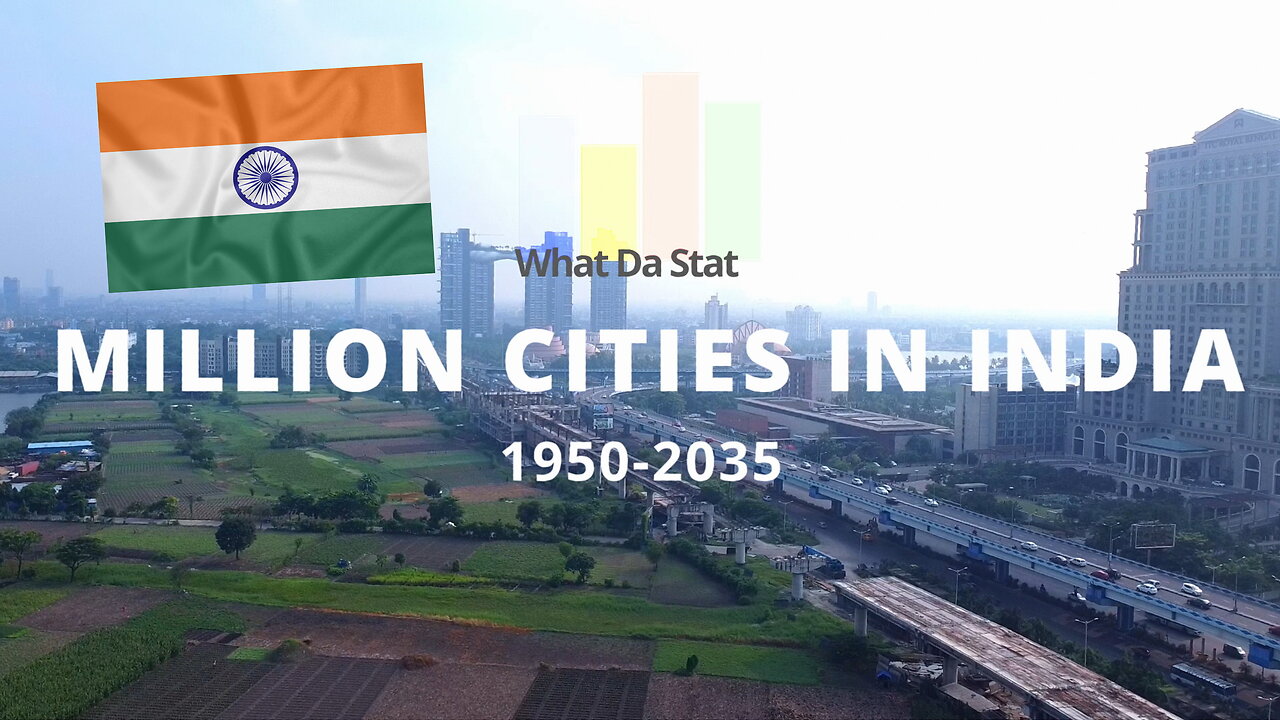Premium Only Content

Million Cities in India 1950-2035
This bar chart race shows urban agglomerations in India with over one million urban population, and urbanization in percentage and total urban population, from 1950 to projected in 2035.
The Eckert IV projection is used as map depiction.
The capital of India is New Delhi. Urban agglomeration data for Delhi National Capital Region (NCR) also include metropolitan area that is not restricted to state boundaries of National Capital Territory (NCT). I.e. contiguous suburban cities and towns, such as Faridabad, Gurgaon, and Ghaziabad.
Despite a high total urban population, the urbanization in percentage is relative low compared to many other countries for several reasons:
Large Rural Population: A significant portion of India's population still resides in rural areas, relying on agriculture and related activities for their livelihood. Despite urbanization trends, the rural population remains substantial.
Historical and Economic Factors: India has a long history of being an agrarian society. Economic development and industrialization, which drive urbanization, have occurred at a slower pace compared to some other nations. Many rural areas have not seen the same level of industrial growth that typically leads to urbanization.
Infrastructure and Urban Planning: Rapid urbanization requires extensive infrastructure and urban planning. India faces challenges in developing adequate urban infrastructure to support a larger urban population, including housing, transportation, water supply, and sanitation.
Government Policies: Policies and programs aimed at rural development, such as subsidies for agriculture and rural employment schemes, have helped sustain rural populations. These policies can slow the rate of rural-to-urban migration.
Social and Cultural Factors: Many people in India have strong cultural and familial ties to their rural communities. These ties can make people less inclined to migrate to urban areas, even when economic opportunities are more plentiful there.
Urban-Rural Disparities: The disparity in living conditions and opportunities between urban and rural areas can discourage urban migration. While cities offer more economic opportunities, they also come with challenges such as high living costs, congestion, and pollution.
While space constraints are also significant factors, they are intertwined with broader economic, social, and infrastructural issues that collectively influence the pace and nature of urbanization in India.
Countries like the United States, most of Europe, and Japan have much higher urbanization rates, often exceeding 80%. This is due to earlier industrialization, economic development, and smaller rural populations. India’s urbanization rate is comparable to some other developing nations but lags behind rapidly urbanizing countries like China, which has aggressively pursued urbanization through state policies and massive infrastructure projects. India’s urbanization is an ongoing process, and while it is less than 40% currently, it is expected to increase as the country continues to develop economically and infrastructure improves.
Data sources and projections: World Bank and UN
Music: Stellardrone - Pluto https://soundcloud.com/stellardrone/pluto
Data visualization created with flourish.studio https://flourish.studio
-
 3:44:24
3:44:24
Barry Cunningham
6 hours agoBREAKING NEWS: LIVE COVERAGE OF NEW YORK POLICE OFFICERS UNDER SIEGE!
75.7K64 -
 2:51:25
2:51:25
The Pascal Show
4 hours ago $0.34 earnedBREAKING! Active Shooter In Midtown Manhattan NYC Multiple People Shot!
11.7K -
 10:25
10:25
MattMorseTV
9 hours ago $2.05 earnedVance just DROPPED a NUKE.
27.1K38 -
 LIVE
LIVE
Jokeuhl Gaming and Chat
6 hours agoDARKTIDE - Warhammer 40k w/ Nubes and AoA
176 watching -
 2:53:08
2:53:08
Shoriantrax
3 hours agoLIVE: Hardcore Chaos in Tarkov – Loot, Die, Repeat!
5.99K -
 LIVE
LIVE
John_Goetz
3 hours agoJohn Gets Gaming - Medal of Honor Vanguard Part 2
9 watching -
 1:29:09
1:29:09
RiftTV
5 hours agoSydney Sweeney Spreading RACIST Propaganda? | The Rift | Guest: Braeden Sorbo + Sarah Stock
36.2K9 -

VapinGamers
4 hours ago $0.01 earnedDestiny 2 - The Premium Destiny 2 Experience with the Community! - !rumbot !music
2.23K -
 LIVE
LIVE
We Like Shooting
17 hours ago $0.08 earnedWe Like Shooting 621 (Gun Podcast)
66 watching -
 2:06:45
2:06:45
PudgeTV
9 hours ago🔵 Mod Mondays Ep 69 | Grimm Hollywood - The 3k on Mod Mondays
13.2K3